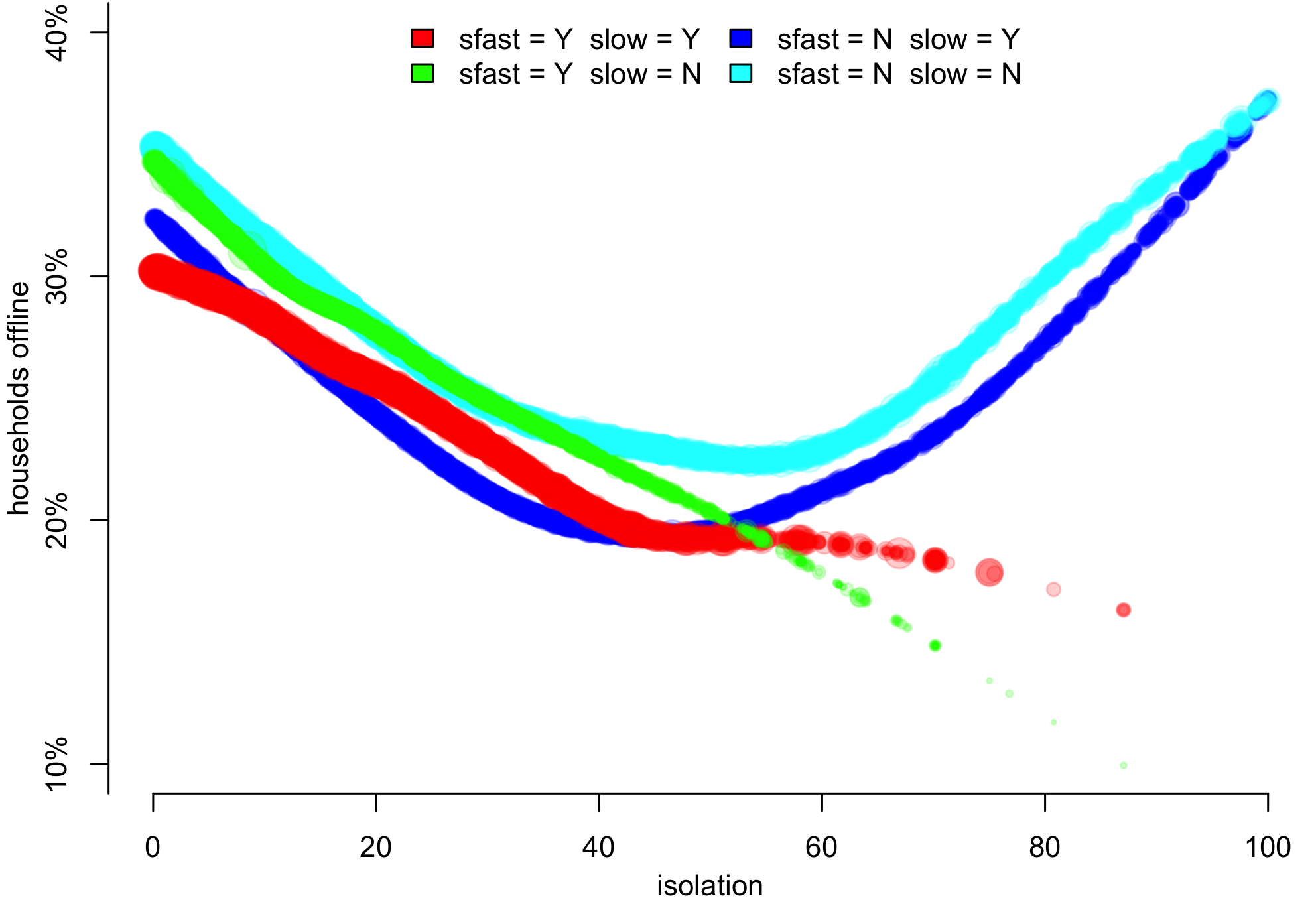This figure shows how the proportion of households offline varies with isolation for four different sets of postcodes.

In some Scottish postcodes covered by the Ofcom data, there are superslow lines, with sync speeds less than 2.2 Mb/s; in some, next-generation "superfast" connections are available. We use these two features to divide the households in Scotland into six sets as shown in the following table. (The postcodes for which slowlines data is not available are those with less than three recorded connections. They account for around 3% of households in Scotland.)
| superfast | |||
|---|---|---|---|
| Y | N | ||
| slowlines | Y | 504,416 | 574,743 |
| N | 813,522 | 569,244 | |
| NA | 21,180 | 55,175 | |
For each of the coloured sets, those where we have data on slowlines, we plot a curve showing how the proportion of households offline varies with isolation.
We use the SIMD access score (rather than SIMD access rank) as the basis for this model, as this gives a better linear fit to the data. We see that, where there are superfast lines, but no slowlines, the response appears linear. This linear response covers most of the population; an isolation score of 40 on our scale corresponds to the 85th centile of households, ordered by isolation; and a score of 70 corresponds to the 96th centile.
We interpret the near coincidence, for moderate degrees of isolation, of the two curves with no superslow lines, as indicating that the availability of superfast connections has little effect on demand. (A score of 40 for isolation corresponds to the 84th centile of population.) The increasing divergence beyond this point suggests that, in general, access becomes increasingly problematic for the final 15%.
Where superfast is not available, we interpret the separation of the blue (with slowlines) and cyan (without slowlines) lines as evidence that slowlines signal an aspect of isolation not captured by the SIMD statistic, that leads to increased demand. The deviations from linearity are again consistent with our suggestion that access becomes increasingly problematic for the final 15%.
The is a similar shift between the two lines with superfast. The red line (with slowlines) shows fewer households offline than the green (with slowlines). This shift is smaller, presumably because (at least parts of) those postcodes with superfast and slowlines are less isolated than postcodes with slowlines but no superfast.
Where there is superfast, but no slowlines, it appears that access is not a problem. Remote postcodes, those on the red line, with both superfast and slowlines, vary.
We use the model dataset,
and fit the two parameters of a beta-binomial distribution, as smooth
functions (each with 5 degrees of freedom) of isolation, using a
generalised additive model, provided by the VGAM package in R. The lines are drawn using the following code:
for (slow in c("Y","N")){
for (fast in c("N","Y")){
m <- subset(model, slowlines == slow & superfast == fast)
simdgam <-
vgam(formula =
cbind(offline,
connected)
~ s(isolation,df=5),
family = betabinomial.ab,
data = m,
trace = TRUE,
)
p <- exp(predict(simdgam))
symbols(m$isolation,
qbeta(0.5, shape1=p[,1],shape2=p[,2]),
circles=sqrt(m$Household_Count),
inches=0.1,
fg=alpha(
ifelse(fast=="Y",
ifelse(slow=="Y","red","green"),
ifelse(slow=="Y","blue","cyan")),
0.2),
bg=alpha(
ifelse(fast=="Y",
ifelse(slow=="Y","red","green"),
ifelse(slow=="Y","blue","cyan")),
0.2),
add=T)
}
}